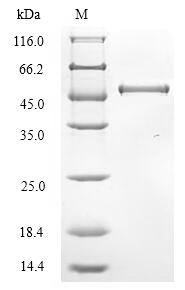Hemagglutinin-esterase (HE) is a glycoprotein found in various viruses, including coronaviruses and influenza viruses. In coronaviruses, HE acts as a second viral attachment protein alongside the spike protein, facilitating the initiation of infection [1]. It plays a crucial role in receptor binding, receptor destroying, and membrane fusion activities in influenza C viruses, while influenza A and B viruses have separate proteins for these functions [2]. HE has been identified as a structural protein in SARS-CoV-2, contributing to the entry and release processes of the virus [3].
The enzymatic activity associated with HE is linked to its homodimeric structure, influencing virus evolution and interactions with host cells [4]. Studies have shown functional similarities between HE proteins of different viruses, such as infectious salmon anaemia virus, toroviruses, and influenza C virus, indicating a conserved role across viral families [5]. The HEF protein in influenza D virus has been highlighted for its exceptional stability and multifunctionality in receptor binding, destroying, and membrane fusion [6].
In terms of viral classification, influenza C viruses possess the hemagglutinin-esterase-fusion (HEF) protein as their primary surface glycoprotein, distinguishing them from influenza A and B viruses [7]. The genetic and antigenic diversity of influenza D viruses in cattle has been linked to the presence of distinct lineages of HE proteins [7]. Furthermore, the HE gene in coronaviruses is positioned adjacent to the spike protein gene, emphasizing its significance in viral structure and function [8].
References:
[1] T. Kienzle, S. Abraham, B. Hogue, & D. Brian, "Structure and orientation of expressed bovine coronavirus hemagglutinin-esterase protein", Journal of Virology, vol. 64, no. 4, p. 1834-1838, 1990. https://doi.org/10.1128/jvi.64.4.1834-1838.1990
[2] B. Hause, M. Ducatez, E. Collin, Z. Ran, R. Liu, Z. Shenget al., "Isolation of a novel swine influenza virus from oklahoma in 2011 which is distantly related to human influenza c viruses", Plos Pathogens, vol. 9, no. 2, p. e1003176, 2013. https://doi.org/10.1371/journal.ppat.1003176
[3] M. Zandi and S. Soltani, "Role of hemagglutinin‐esterase protein in sars‐cov‐2 infection?", Cell Biology International, vol. 45, no. 11, p. 2198-2198, 2021. https://doi.org/10.1002/cbin.11683
[4] Q. Zeng, M. Langereis, A. Vliet, E. Huizinga, & R. Groot, "Structure of coronavirus hemagglutinin-esterase offers insight into corona and influenza virus evolution", Proceedings of the National Academy of Sciences, vol. 105, no. 26, p. 9065-9069, 2008. https://doi.org/10.1073/pnas.0800502105
[5] A. Müller, T. Markussen, F. Drabløs, T. Gjøen, T. Jørgensen, S. Solemet al., "Structural and functional analysis of the hemagglutinin-esterase of infectious salmon anaemia virus", Virus Research, vol. 151, no. 2, p. 131-141, 2010. https://doi.org/10.1016/j.virusres.2010.03.020
[6] J. Yu, B. Hika, R. Liu, Z. Sheng, B. Hause, L. Fenget al., "The hemagglutinin-esterase fusion glycoprotein is a primary determinant of the exceptional thermal and acid stability of influenza d virus", Msphere, vol. 2, no. 4, 2017. https://doi.org/10.1128/msphere.00254-17
[7] E. Collin, Z. Sheng, Y. Lang, W. Ma, B. Hause, & L. Feng, "Cocirculation of two distinct genetic and antigenic lineages of proposed influenza d virus in cattle", Journal of Virology, vol. 89, no. 2, p. 1036-1042, 2015. https://doi.org/10.1128/jvi.02718-14
[8] D. Brian, B. Hogue, & T. Kienzle, "The coronavirus hemagglutinin esterase glycoprotein",, p. 165-179, 1995. https://doi.org/10.1007/978-1-4899-1531-3_8






